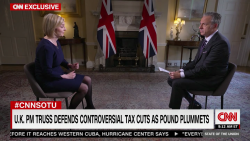Millions of mortgage borrowers in the United Kingdom are bracing themselves for huge hikes to their monthly payments as a consequence of the run on the pound.
Markets have been in turmoil since UK finance minister Kwasi Kwarteng announced the biggest tax cuts in 50 years on Friday, together with a big rise in government borrowing, sending the pound falling to a record low against the US dollar.
Some analysts now expect the Bank of England to hike the cost of borrowing to 6% next year, up from 2.25%, to shore up the currency and convince markets that it’s committed to getting inflation under control.
“It is hard not to draw the conclusion that [recent events] will require a significant monetary policy response,” Huw Pill, the central bank’s chief economist told the Barclay’s-CEPR International Monetary Policy Forum on Tuesday, according to a Reuters report.
Markets had already been expecting the central bank to raise interest rates to 4.75% by next spring. That would have added £201 ($217) to a typical homeowner’s monthly payment on an outstanding fixed-rate mortgage of £146,000 ($157,000), Laura Suter, head of personal finance at investment firm AJ Bell, told CNN Business. Now borrowers face an even bigger cliff edge.
There are 9 million outstanding residential mortgages in the United Kingdom, according to UK Finance, an association of banks and financial services firms. About 20% of those loans are tracker, or variable rate products, that typically become more expensive when the central bank hikes rates. The rest are fixed-rate loans.
But as many as 1.8 million borrowers will have to refinance next year, according to the Resolution Foundation. Neal Hudson, a housing market analyst at research firm BuiltPlace, estimates that about 300,000 fixed-rate deals will come to an end between October and December. Those borrowers face a sudden increase in their monthly payments should they refinance.
If the base rate rises to 6%, a person refinancing a 20-year fixed-rate mortgage of £146,000 ($157,000) will have to pay an extra £309 ($333) per month, according to Suter. That’s £108 ($116) more than estimated before the pound’s crash.
Many borrowers won’t be able to cope. Samuel Tombs, chief economist at Pantheon Macroeconomics, said in a Tuesday report that a 6% mortgage rate would “lead to a sharp rise in mortgage defaults.”
He calculates that the average household refinancing a 2-year fixed rate mortgage in the first half of next year would see its monthly repayment jump by a whopping 73% to £1,490 ($1,607), an increase equivalent to about 14% of disposable income.
“Mortgage arrears and default would rise just as house prices likely would be tumbling, placing huge strain on banks’ balance sheets,” he said in the report.
Some mortgages have been withdrawn and rates are already rising
Banks are already becoming more risk-averse as they struggle to reprice their mortgages in such volatile markets.
Since Friday, lenders have withdrawn more than 350 mortgage products in response to the turmoil, according to Moneyfacts, a financial product comparison website.
Halifax, owned by Lloyds Bank (LLDTF), removed some of its mortgage products, while Virgin Money stopped taking mortgage applications from new customers until later this week.
On Tuesday, Santander (SAN) said it would remove mortgages worth 60% and 85% of a property’s value for new UK customers, and increase rates for “new and existing customers from 10 p.m. this evening.”
“Customers who have already applied by this time will not be impacted,” a company spokesperson told CNN Business in a statement.
Borrowers are worried. Online searches for “remortgage” more than doubled in the United Kingdom on Monday, according to analysis of Google search data by Loan Corp, a mortgage broker.
Some may now struggle to find any deals at all.
“Those with smaller deposits or who are trying to borrow at their maximum affordability might find it harder to get a mortgage deal or that they are paying even higher rates to do so,” Suter said.
— Julia Horowitz contributed reporting.






















